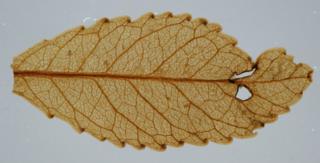
Image copyright
Jennifer Bannister / Uni Otago
Fossil leaves from the remains of a 23 million-year-old forest suggest some plants may adapt to grow more quickly as CO2 levels rise, a study says.
Scientists recovered the very well-preserved leaves from an ancient lake on New Zealand’s South Island.
They have enabled the scientists to link for the first time the high temperatures of the period with high levels of atmospheric CO2.
The results have been published in the journal Climate of the Past.
In their scientific paper, the team shows that some plants were able to harvest carbon dioxide more efficiently for photosynthesis – the biological process that harnesses light from the Sun to produce food for the plant.
They say their findings may hold clues for how the dynamics of plant life could shift as current CO2 levels rise to meet those of the distant past.
What can we learn from these ancient leaves?
The team drilled 100m down to near the bottom of the now-dry lake bed, located in the crater of a long-extinct volcano. The crater is about a kilometre across.
Here, biological material has been fossilised, including the remains of plants, algae, spiders, beetle, flies, fungi and other living things from a warm period known as the early Miocene Epoch.
Image copyright
Daphne Lee / Uni Otago
Average global temperatures are thought to have been between 3C and 7C higher than today, and ice largely disappeared from the poles.
There is debate among scientists about levels of CO2 in the period, which is one reason this study is so interesting.
“The amazing thing is that these leaves are basically mummified, so we have their original chemical compositions, and can see all their fine features under a microscope,” said lead author Tammo Reichgelt, of Columbia University’s Lamont-Doherty Earth Observatory in New York, US.
He says they are preserved so perfectly that microscopic veins and stomata – the pores which allow leaves to take in air and release water during photosynthesis – are visible.
The scientists analysed the different chemical forms of carbon – or carbon isotopes – within leaves from a half-dozen tree species found at various levels in the deposit.
This helped them estimate the carbon content of the atmosphere at the time.
They concluded it was around 450 parts per million (ppm).
Previous studies – mainly using marine organisms – have suggested it was significantly lower, around 300 ppm.
That is similar to those in pre-industrial times, and not enough to account for the much higher temperatures of the early Miocene.
Human emissions have now pushed CO2 levels to about 415 ppm.
They are expected to reach 450 ppm in the next few decades – the same level experienced by those forests in New Zealand 23 million years ago.
Image copyright
William D’Andrea
The researchers also analysed the geometry of the leaves’ stomata and other anatomical features, and compared them with those of modern leaves.
They showed that the trees were unusually efficient at sucking in carbon through the stomata, without leaking much water through the same route – a key challenge for all plants.
This allowed the trees to grow in marginal areas that otherwise would have been too dry for forests.
The researchers say this higher efficiency was very likely mirrored in forests across the northern temperate latitudes, where more of the Earth’s landmass is located.
What does this tell us about today?
When CO2 levels rise, many plants increase their rate of photosynthesis, because they can more efficiently remove carbon from the air, and conserve water while doing so.
Data from Nasa satellites shows a “global greening” effect mainly due to rising levels of CO2 released by human activities over recent decades.
It has been estimated that a quarter to a half of the planet’s vegetated lands have seen increases in leaf volume on trees and plants since about 1980.
Image copyright
Tammo Reichgelt
The effect is expected to continue as CO2 levels rise.
But the authors of the new report say we shouldn’t assume this is necessarily good news.
Increased CO2 absorption will not come close to compensating for what humans are pouring into the air.
And, because much of today’s plant life evolved in a temperate, low-CO2 world, some natural and agricultural ecosystems could be seriously disrupted by higher CO2 levels, along with the rising temperatures and shifts in precipitation they bring.
Not all plants can take advantage, and among those that do, the results can vary depending on temperature and availability of water or nutrients.
There is evidence that when some major crops photosynthesise more rapidly, they absorb relatively less calcium, iron, zinc and other minerals vital for human nutrition.
“How it plays out is anyone’s guess,” said Dr Reichgelt. “It’s another layer of stress for plants. It might be great for some, and horrible for others.”
How are the leaves so well-preserved?
The deposit is located on a farm near the southern New Zealand city of Dunedin.
In the ancient crater lake, successive layers of sediment built up from the surrounding environment over tens of millions of years.
The lake was deep and had low oxygen levels at its bottom, which means that any prehistoric leaves that sank down there stayed relatively well-preserved, despite being 23 million years old.
These include countless leaves from a sub-tropical evergreen forest.
The deposit has a layered structure with blackish organic matter alternating with bands of white-ish silica-rich material laid down by algae that bloomed each spring.
The feature was recognised only within about the last 15 years; scientists dubbed it Foulden Maar.
It is the only known deposit of its kind in the Southern Hemisphere, and far better preserved than the few similar ones known from the north.
What was it like working with such ancient material?
Tammo Reichgelt said he felt a big responsibility and “a strange sort of reverence” working with fossils of this quality that have lain undisturbed for so long.
He described excavating the fossil material from a pit dug into deposits in the crater.
It was exposed to the elements, “very windy, sunny and saturated with rain”.
That made the work very challenging.
“The largest leaf I ever found was on a wet day and the brittle rock crumbled in my hand with the leaf on it”, he told the BBC.
“There was no saving it. When this sort of thing happens, your stomach drops and you feel like you’ve just destroyed a pharaoh’s tomb.”
Follow Justin on Twitter.
Read MoreFeedzy


